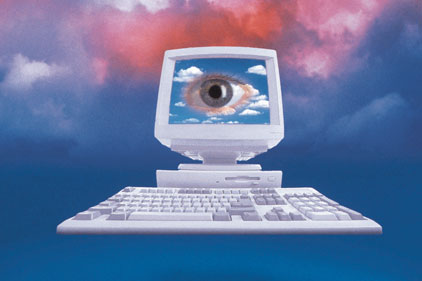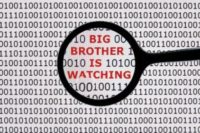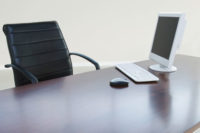Rita put the pedal to the metal to get to her customer on time. But a sensor picked up her speeding and an automated voice from the dashboard alerted her to slow it down. This reminded Rita of the new high-tech dinner forks she had bought her kids for Christmas — smart “healthy eating” utensils that buzz and vibrate when the fork is shoveling food into a mouth too fast.
Racing to work, Rita wondered how this was affecting her stress level. She packs a pocket-size personal stress reliever. Through an earlobe attachment or thumb sensor (a poor choice when driving), it measures Rita’s heart-rate variability. Once at her desk, Rita can use the device as a sort of meditation assistant. Breathing in unison with a climbing and descending column of illuminated beads, she can reach relaxed awareness before digging into work.
On each of her wrists, Rita wears activity trackers. They form her personal wellness program. One records how many steps she takes, stairs climbed, and calories burned. It beams motivational coaching messages such as “steponit” and “yourock.” The other downloads data at the day’s end into Rita’s smartphone using a jack. It too tracks her daily movements, and in night mode, the hours spent in light and deep sleep, and how many times Rita wakes up.
The data-driven life
Rita’s data-driven life puts her way ahead of the curve in what is known as the “Quantified Self” movement. Self-tracking leads to self-knowledge through numbers. Personnel tracking is nothing new; various gadgets have been around for at least the past decade. But it is catching on. It’s important to Rita because she is one of more than 23 million so-called “lone workers.” It’s the ever-expanding army of foot soldiers in the growing service economy. It’s composed of sales people like Rita; truck, delivery and taxi drivers; home healthcare workers; convenience store clerks; field service repair workers; and many others. Her company invested in a location-based service to monitor lone workers, who are vulnerable to attack, abuse, threats and accidents. The wireless system is integrated with Rita’s cell phone, enabling her supervisor to track her and other lone workers, both indoors and outdoors, in real time, to ensure they are both safe and on task, not hanging out at Panera’s for a couple of hours playing with an iPad.
If Rita encounters an emergency, she can signal a panic alert for police or other responders to quickly arrive on the scene. She’s less comfortable with some of the non-safety functions of the tracking system. Her daily number of sales calls is now documented. So too is her percentage of making calls on time as scheduled. The total hours she works each day is transparent. It’s a trade-off. She does feel more protected. And part of the reason her company invested in the tracking system had nothing to do with personal safety; it is a way to measure employee productivity and efficiency; ensure accuracy of reporting; document response times to bolster customer satisfaction; optimize the routes taken to clients (to save time and gas and reduce that carbon footprint) and ensure sales people are maximizing their time seeing multiple clients in a given location.
Real-time situational awareness
Personnel location tracking has applications far beyond monitoring mobile workers. It’s been used in the military for years. Real-time location awareness systems are used on oil platforms, refineries, chemical plants, warehouses, and sprawling industrial complexes. Fire-fighting is a particularly apt application. Sensors and RFID tags strapped to clothing automatically turn on, log in the fire-fighter to the command base, and instantly update commanders as to who is inside the building footprint, their location and status. Dire, man-down situations activate external rescue.
In the event of a worksite explosion, fire or other catastrophe, wireless personnel tracking improves crisis management by quickly locating and accounting for workers, and locating missing or specific personnel with accuracy. One system on the market counts people in lifeboats evacuating oil and gas platforms. Another system tracks permit-to-work employees and ensures they are working in the correct zones. Only workers with permits are permitted to work in defined work zones. This system was also piloted at a steel mill in combination with software to enhance visibility and protect workers around blast furnances.
Integration: the Holy Grail
Tracking technology has the potential to integrate safety functionality with operations functionality. That’s due to the many business apps beyond worker protection: security access control; inventory management; lab sampling tracking; field service; store delivery; asset management tracking that can, for example, track textiles from roll to rack; and automatically managing traffic flow in and out of loading docks and warehouses.
Some marketers of personnel tracking systems believe high-tech situational awareness can be a radical game-changer in workplace safety, especially if prices keep falling. Can you imagine the safety department of the future resembling an air traffic control tower or nuclear plant surveillance center, with personnel eyes focused on 3-D visual images and mapping software? Just keep Homer Simpson out of the room.
Safety personnel would not be chained to computer terminals and monitors. Tablet devices and smartphones allow personnel to be out in the field, combining traditional observational oversight with real-time data inputs from both workers and work zones.
As with any new safety initiative, there will be resistance. Some workers will complain they are being collared and tagged like criminals. Where’s management’s trust? Why resort to Big Brother tactics? For lone workers like sales people, what happened to the idea of flex time and freedom to work your own hours, as long as the job gets done?
Still, apps will only multiply. One smartphone app alerts drivers when it detects signs of sleepiness, like head position, blinking rate, and yawning. The device is programmed to work on smartphones equipped with dual cameras that face both road conditions and the driver. Able to detect vehicle drifting, the distance between cars, and distracted drivers, a blinking light or noise alert gives drivers a wake-up call to avoid crashes. The day is coming when workplace safety practices will be swept up in the tech tide. Just ask Rita.
Editor’s note: All the technology referenced in this column exists and is on the market. We deleted brand names to avoid commercial promotion.



